Jaw Grading Oral Motor Exercises with ARK's Bite Blocks
Posted by Debbie Lowsky, MS, CCC-SLP on 31st Mar 2020
I always love adding new tools to my oral motor toolbox, and the Bite Blocks are no exception. These handy oral motor tools come in two different versions, both of which can be used to work on jaw grading and stability:
1. Bite Blocks - a standalone non-vibratory set, as pictured below. This version is nice when you don't need vibration. Because each arm is longer, you can also practice bilateral jaw strength with these (see the Bilateral Bite exercise below).
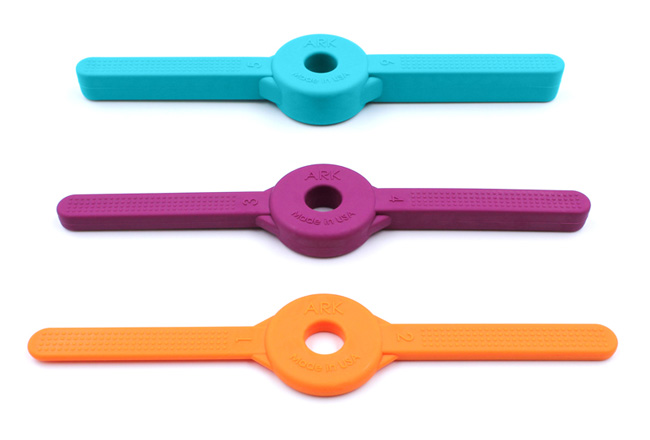
2. Y Tip Bite Blocks - these are tip attachments versions of the Bite Blocks, to be used with the Z-Vibe. The Z-Vibe provides added sensory input through vibration. The tip versions are great for when you want additional sensory stimulation. As an added bonus, the Y shape also works well for lip closure activities.
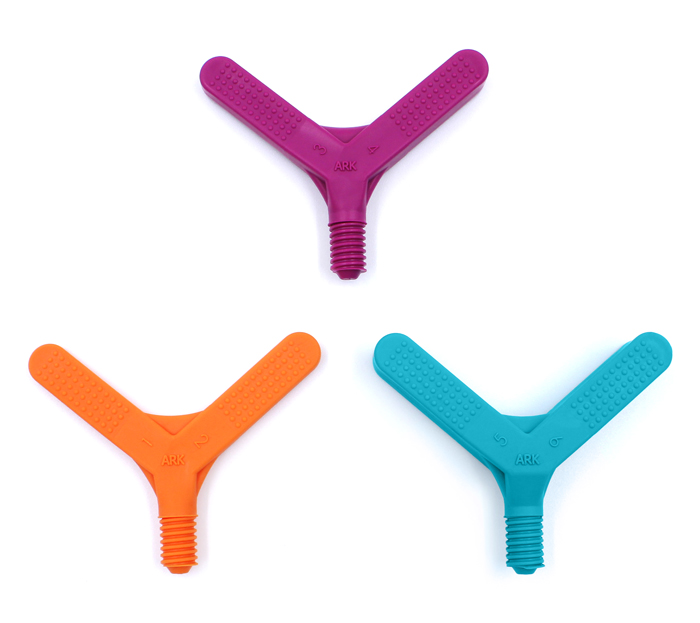
What is jaw grading?
Jaw grading is the ability to have controlled movements of the jaw to various jaw heights needed for speech and feeding skills. For example, imagine biting into a cracker versus a sandwich/burger and how wide your mouth (aka how low your jaw) needs to be to eat those different foods. Or, compare the difference between saying “eee” versus “ahhh”. For eating a cracker or saying "eee" - your mouth has to open just a little bit (aka the jaw is in a high position). For eating a burger or saying "ahhh", your mouth has to open a lot more (aka the jaw needs to be in a lower position). Jaw stability is the strength, coordination, and endurance needed to do all of the above without the jaw sliding forward and/or sideways.
Each "arm" of the Bite Blocks has a different thickness to practice these various jaw heights:
- The orange arms are .125" and .2" thick (labeled 1 and 2 respectively)
- The magenta arms are .3" and .4" thick (labeled 3 and 4 respectively)
- The teal arms are .5" and .6" thick (labeled 5 and 6 respectively)
.
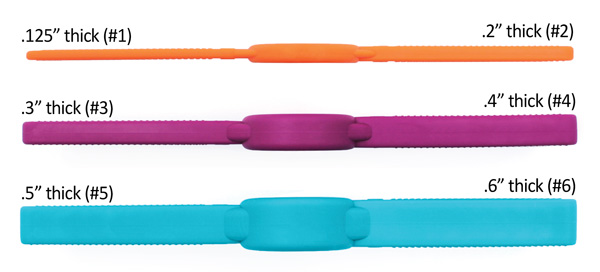
.
Below are some oral motor exercises to work on jaw grading and stability using the Bite Blocks. For the Bite & Hold, Tug & Pull, and Bite & Open/Close exercises, ideally you’ll want to insert the block straight into the mouth on top of the molar surface (as shown in Fig. 1 below). This placement is preferable, but if that’s not possible you can try inserting the block from the side. Some individuals may find the first method too invasive and be more comfortable with it from the side at first.
BITE AND HOLD:
- Place the block in between the pre-molars on one side of the mouth (see Fig. 1).
- Instruct the individual to bite and hold for 5-10 seconds.
- Repeat on the other side of the mouth.
- Then repeat twice more on each side (3 total sets).
TUG AND PULL:
- Place the block in between the pre-molars on one side of the mouth.
- Instruct the individual to bite down and sustain the bite for 5-10 seconds while you gently pull on the block for resistance.
- Repeat on the other side of the mouth.
- Then repeat twice more on each side (3 total sets).
BITE AND OPEN/CLOSE:
- Place the block in between the pre-molars on one side of the mouth.
- Instruct the individual to bite down on the block.
- Then have the individual open and close the jaw 5-10 times while you hold the block in place. Watch for good jaw alignment and rhythmic movement.
- Repeat on the other side of the mouth.
- Then repeat twice more on each side (3 total sets).
- This exercise works best with the thinner blocks (#1 through #3).
.
BILATERAL BITE:
- Place the block laterally in front of the mouth in between the pre-molars (see Fig. 2).Instruct the individual to bite and hold for 5-10 seconds (so that they’re biting on both sides of the mouth at the same time symmetrically).Repeat twice more.
- Then do a “tug and pull” exercise.Have the individual bite down and sustain the bite for 5-10 seconds while you gently pull the block towards you for resistance.Hold on to both ends of the block while you pull forward.Repeat twice more.
- For this exercise you'll need to use the regular Bite Blocks (the Y Tips are not long enough for this exercise)
.
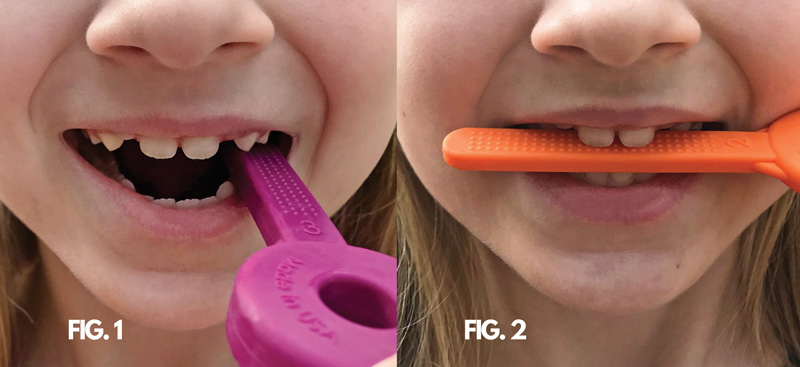
.
Which bite block thickness should you use for the exercises above?
This will depend on the individual’s age and range of ability. With individuals who have low tone and a low jaw position for example, you’ll probably start with the thicker blocks and work towards the thinner ones. With young individuals, the thickest ones may be too large so you’ll start with #4 or #3.
With some individuals, you may use all six levels. In other cases you’ll find a “sweet spot” of 2-3 levels that work for a certain individual.
If an individual isn’t able to bite down on a block and hold onto it, go up to a thicker bite block and try that one. For example, if #4 keeps sliding out from between the teeth, try #5 instead.
The goal is to work towards being able to use the thinnest (#1) bite block, as this requires the most refined movement and control of the jaw.
.
NOTES/TIPS:
- For the jaw exercises above: ideally you’ll want to insert the block straight into the mouth on top of the molar surface. This placement is preferable, but if that’s not possible you can try inserting the block from the side. Some individuals may find the first method too invasive and be more comfortable with it from the side at first.
- Model first (on yourself or on a puppet/doll/sibling/etc.) what you want the individual to do.
- Make sure the jaw is doing all of the work without the head or body pulling or moving to assist.
- Make sure the individual has good sitting position and posture. The ankles, hips, and knees should be at a 90-90-90 degree angle. Consult with an OT and/or PT if necessary. To work on jaw stability, the body must be stable in alignment first.
- Jaw movements should be smooth, symmetrical, vertical, and aligned at midline (upper teeth lining up with lower teeth).
- 5-10 seconds/repetitions is a general guideline, but may depend on the child’s age and abilities. For example, if the individual is already doing 5-10 seconds, you may want to bump up to 15 seconds. Establish a baseline and adjust accordingly.
- If any gagging is noted, the bite block is too large. Switch to a thinner block.
- If at any point the individual cannot complete an exercise, note how far the individual got by counting the seconds. Then take a break. Try another goal/activity and revisit the exercise later. If it’s still too difficult, try again in the next session and keep practicing.
- Follow up each exercise with a functional task when applicable. For example, after biting on the thinnest bite block, prompt the individual to say “eee”. After biting on the thickest block, prompt the individual to say “ahhh”.
- If necessary, use your thumb and pointer finger of one hand to assist the jaw to open and close.
- The Y Tips are also available in a standalone, non-vibratory Bite Block set here. All of the same jaw exercises can be done with these as well.
- Keep track of progress using an extended version of a chart like the one below.
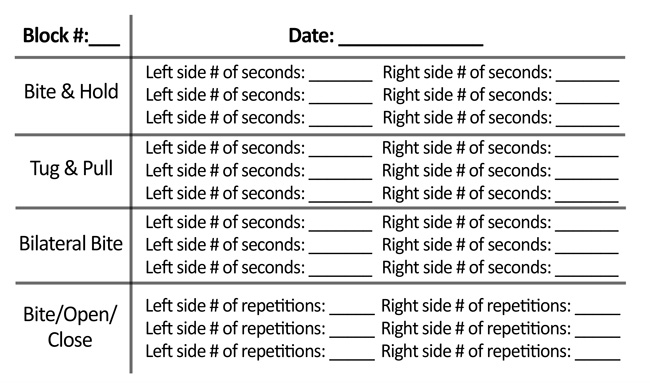
.
Debbie Lowsky, MS, CCC-SLP
.

